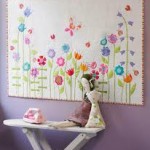8 Tips for Reverse Applique
By Holly Hanover
Reverse applique is not nearly as complex as it sounds. It is essentially the same as direct applique except that two or more pieces of fabric are layered. The top layer(s) of fabric are cut away to reveal the hidden fabric and create lovely and impressive results. It is a great and simple way to add visual interest and compelling texture to your quilting and craft projects.
What follows are some simple tips to ensure professional looking results in your reverse applique endeavors:
- Wash and starch all your fabric pieces (for this article we will assume you are using two). This helps them to lie flat, makes them easier to work with, and ensures a clean presentation when complete.
- Freezer paper makes a great stabilizer. To give your motif a crisp, clean edge, freezer paper works wonders. Just remember to pull the paper out before you completely stitch your applique in place. Also: when drawing directional designs (like lettering), make sure to transfer them backwards so they are facing the right way when finished.
- Make the markings on the WRONG side of the TOP layer of fabric when transferring your pattern. The markings you make here will be the seam line that you sew upon with your machine. However, by marking them on the wrong side you will actually be able to see them as you fold them under and iron!
- Fold the fabric when cutting away the insides of the design. This is the best way for cutting out your reverse applique pattern where the bottom layer of fabric will show through. For better control, use embroidery scissors.
- Clip all curves and corners in the seam allowance. This is essential to get your design to lie flat. Then, fold in your seam allowance while CAREFULLY ironing it flat.
- Cut the BOTTOM layer of fabric without a seam allowance. Do this so that when you place the top layer on, the raw edges of the bottom are flush with the folded seam allowance of the top. Layer them both right side facing when pinning in place.
- Water-soluble thread can be used as an alternative to blind stitching your layers together. This thread will wash out so you don’t have to worry about making it “perfect”.
- Keep a toothpick handy to tuck back in any naughty edges that might pop up as you machine stitch your reverse applique in place.
CLICK HERE FOR THE BEST SCISSORS FOR APPLIQUE

